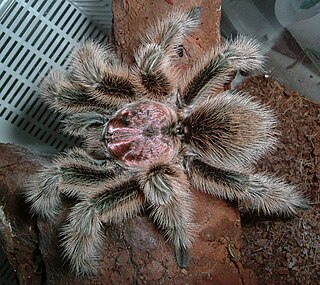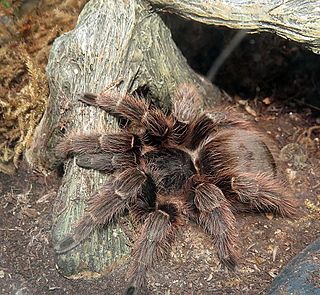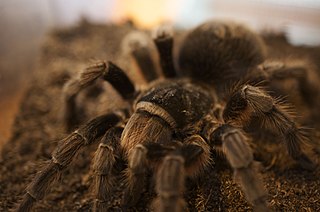
Wolf spiders are members of the family Lycosidae. They are robust and agile hunters with excellent eyesight. They live mostly in solitude, hunt alone, and usually do not spin webs. Some are opportunistic hunters, pouncing upon prey as they find it or chasing it over short distances; others wait for passing prey in or near the mouth of a burrow.

The Chilean rose tarantula, also known as the rose hair tarantula, the Chilean fire tarantula, or the Chilean red-haired tarantula, is probably the most common species of tarantula available in American and European pet stores today, due to the large number of wild-caught specimens exported cheaply from their native Chile into the pet trade. The species is also known from Bolivia and Argentina.

Avicularia is a genus of the family Theraphosidae containing various species of arboreal tarantulas. The genus is native to Panama, the Caribbean and tropical South America. Each species in the genus has very distinguishable pink foot pads.

Grammostola is a genus of South American tarantulas that was first described in text by Eugène Louis Simon in 1892. These medium- to large-sized spiders are native to tropical South America, and are usually brown in color, with pinkish or orangish-red hairs. The very docile Chilean rose tarantula is popular as a beginner's spider among tarantula enthusiasts.

The black-headed night monkey is a night monkey species from South America. It is found in Brazil, Bolivia and Peru. The A. nigriceps in Peru were notably inhabiting areas that were degraded, and often these areas were disturbed either by human activities or natural occurrences in the ecosystem. A black-headed night monkey is about the same size as a small squirrel. Black-headed night monkeys have small ears that are hidden by their fur. When they become adults they are about 750g and usually are about 14 months old. Black-headed night monkeys have three black stripes that meet on their forehead. These monkeys have white patches by their eyes, cheeks, and under their mouth. Their eyes are very large and brown.

Savant is a fictional superhero appearing in American comic books published by DC Comics, depicted as a member of the Birds of Prey and the Suicide Squad.

One of the larger species of tarantula, the Chaco golden knee, formerly known as Grammostola aureostriata, can be expected to reach between 20 and 22 cm (8.5 in).

Grammostola pulchra is a species of tarantula, native to Brazil. It is known for its solid black body, which makes it an appealing tarantula for the pet trade.

Actaeon beetle is a rhinoceros beetle of the family Scarabaeidae.

Eupalaestrus campestratus, known as the pink zebra beauty, is a terrestrial tarantula native to Brazil, Paraguay, and Argentina. It is dark brown and has yellow striped markings near its patellae, resembling Grammostola pulchripes, although its maximum leg span of six inches makes it significantly smaller. It is known for its generally docile and tolerant temperament, and is therefore an attractive pet tarantula to hobbyists who prefer these traits. It is slow moving and generally considered hardy in captivity.

Tarantulas comprise a group of large and often hairy spiders of the family Theraphosidae. As of December 2023, 1,100 species have been identified, with 166 genera. The term "tarantula" is usually used to describe members of the family Theraphosidae, although many other members of the same infraorder (Mygalomorphae) are commonly referred to as "tarantulas" or "false tarantulas". Some of the more common species have become popular in the exotic pet trade. Many New World species kept as pets have setae known as urticating hairs that can cause irritation to the skin, and in extreme cases, cause damage to the eyes.
Grammostola anthracina is a species of spider belonging to the family Theraphosidae (tarantulas). It is found in Uruguay, Paraguay, Brazil, and Argentina.

Megaphobema robustum, known as the Colombian giant tarantula or Colombian giant redleg, was first described by Anton Ausserer in 1875. Found in the tropical rainforests of Colombia and Brazil near logs, it has a span of 6 to 8 inches and will eat crickets, other large insects, small lizards and mice.

Tapinauchenius is a genus of tarantulas that was first described by Anton Ausserer in 1871. The name is a combination of the Greek ταπεινός, meaning "low", and αὐχήν, meaning "neck". In 2022, the genus Pseudoclamoris was transferred to Tapinauchenius.
Cardiopelma is a genus of spiders in the family Theraphosidae. It was first described in 1999 by Vol. As of 2017, it contains only one species, Cardiopelma mascatum, known only from Mexico, in the state of Oaxaca.

Phormictopus auratus, commonly known as the Cuban bronze tarantula, is a species of tarantula endemic to Cuba. It is found in the provinces of Camagüey, Las Tunas and Holguín. It was first described by David Ortiz and Rogério Bertani in 2005, and was named after golden hairs found in this species, auratus meaning golden in Latin.

Grammostola alticeps is a New World spider in the tarantula family (Theraphosidae). It is endemic to Uruguay, Paraguay, and Brazil.

Grammostola grossa, the Guarani giant tarantula, is a tarantula that, like all species of the genus Grammostola, is native to South America. It occurs in Brazil, Paraguay, Uruguay and Argentina. The species was described in 1871 by the Austrian Anton Ausserer, but only received its trivial name Guarani giant Tarantula in the 21st century by the anthropologist Nils Seethaler. The name was given to the spider because of its abundance in the Guarani settlement area, whose agriculture and the associated clearing of forests extended its range.
Grammostola iheringi also known as the Entre Rios tarantula, it was first described by Keyserling in 1891. They are found in Brazil, and is considered the biggest tarantula in the Grammostola genus.














